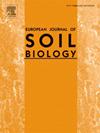Legume integration into rice cropping systems buffers topsoil functional potential against microbial diversity loss
IF 3.3
2区 农林科学
Q1 ECOLOGY
引用次数: 0
Abstract
Intensive cropping systems pose a growing threat to soil microbial diversity, potentially impairing essential agroecosystem functions. Introducing legume crops or implementing fallow periods into these systems are promising strategies to alleviate such negative impacts. However, how these strategies affect the resilience of soil functions to microbial diversity loss remains largely unexplored, particularly in deeper soil layers. In this study, we employed a dilution-to-extinction approach to simulate microbial diversity loss and investigated its effect on functional potential in both topsoil (0–20 cm) and subsoil (40–60 cm) under three crop rotation systems (i.e., rice-fallow, rice-wheat, rice-milk vetch). Soil functional potential was indicated by measuring the copy number of functional genes using high-throughput qPCR. Our results indicate that microbial diversity loss significantly reduced abundance of genes associated with C degradation, C fixation, N mineralization, nitrification, and denitrification in the topsoil of rice-fallow and rice-wheat systems. In contrast, the rice-milk vetch system preserved abundance of these functional genes in the topsoil following microbial diversity loss, highlighting the potential of tailored cropping strategies to counteract the adverse effect of intensive agriculture. Furthermore, while abundance of genes associated with nitrification was also reduced in subsoil by microbial diversity loss, that of genes associated with C degradation and denitrification generally increased for all cropping systems. This highlights the vulnerability of subsoil function potential to microbial diversity loss, potentially enhancing greenhouse gas emissions and contributing to positive climate feedbacks. We concluded that integrating legume crops can maintain soil functional potential in topsoil even in the face of reduced microbial diversity, which is crucial for developing sustainable agricultural practices and ensuring long-term agroecosystem resilience.
豆科作物融入水稻种植系统可以缓冲表层土壤的功能潜力,防止微生物多样性的丧失
集约种植制度对土壤微生物多样性构成越来越大的威胁,可能损害基本的农业生态系统功能。在这些系统中引进豆类作物或实行休耕期是减轻这种负面影响的有希望的策略。然而,这些策略如何影响土壤功能对微生物多样性丧失的恢复能力在很大程度上仍未被探索,特别是在较深的土层中。在本研究中,我们采用稀释到灭绝的方法模拟微生物多样性的丧失,并研究了三种作物轮作制度(即水稻-休耕、水稻-小麦、水稻-豇豆)下表层土壤(0-20 cm)和底土(40-60 cm)微生物多样性对功能电位的影响。利用高通量qPCR检测功能基因拷贝数,确定土壤功能势。研究结果表明,微生物多样性的丧失显著降低了稻休耕和稻麦系统表层土壤中与碳降解、碳固定、氮矿化、硝化和反硝化相关的基因丰度。相比之下,在微生物多样性丧失后,稻-豇豆系统在表土中保留了这些功能基因的丰度,突出了定制种植策略的潜力,以抵消集约化农业的不利影响。此外,虽然土壤中与硝化作用相关的基因丰度也因微生物多样性的丧失而降低,但与碳降解和反硝化作用相关的基因丰度在所有种植制度中普遍增加。这凸显了底土功能潜力对微生物多样性丧失的脆弱性,可能会增加温室气体排放并有助于气候的正反馈。我们得出结论,即使面对微生物多样性的减少,豆类作物也可以保持表层土壤的功能潜力,这对于发展可持续农业实践和确保农业生态系统的长期恢复能力至关重要。
本文章由计算机程序翻译,如有差异,请以英文原文为准。
求助全文
约1分钟内获得全文
求助全文
来源期刊

European Journal of Soil Biology
环境科学-生态学
CiteScore
6.90
自引率
0.00%
发文量
51
审稿时长
27 days
期刊介绍:
The European Journal of Soil Biology covers all aspects of soil biology which deal with microbial and faunal ecology and activity in soils, as well as natural ecosystems or biomes connected to ecological interests: biodiversity, biological conservation, adaptation, impact of global changes on soil biodiversity and ecosystem functioning and effects and fate of pollutants as influenced by soil organisms. Different levels in ecosystem structure are taken into account: individuals, populations, communities and ecosystems themselves. At each level, different disciplinary approaches are welcomed: molecular biology, genetics, ecophysiology, ecology, biogeography and landscape ecology.
 求助内容:
求助内容: 应助结果提醒方式:
应助结果提醒方式:


